Atea changed her sex from female to male and this curious event, I suggest, in a way corresponded to changing from a.m. to p.m. It could also have coincided with the day when once upon a time Leo changed to Virgo. The Babylonians had Denebola and Alaraph close together in their structure.
|
16 |
Zibbat A. |
Tail of the
Lion |
β (Denebola)
Leonis
|
178.3 |
Sept 15
(258) |
|
17 |
Shēpu-arkū
sha-A |
Hind Leg of
the Lion |
β (Alaraph)
Virginis |
178.6 |
Sept 15
(258) |
 |
 |
 |
 |
 |
|
Ga5-1 (111) |
Ga5-2 |
Ga5-3 |
Ga5-4 |
Ga5-5 |
|
JULY 10 |
11 |
12 (193) |
13 |
14 |
|
θ Crateris
(175.0), υ Leonis (175.2), ω Virginis (175.3), ι
Crateris (175.5) |
ο Hydrae
(176.1) |
ζ Crateris,
ξ Virginis (177.0), λ Muscae (177.1), ν Virginis
(177.2), μ Muscae (177.8) |
Al
Sarfah-10 /
Uttara
Phalguni-12 /
Zibbat A.-16 /
Shēpu-arkū
sha-A-17 |
Phekda, β
Hydrae (179.3), η Crateris (179.9)
Deneb Cygni |
|
93 LEONIS
(178.0),
DENEBOLA
(178.3),
ALARAPH
(178.6) |
|
September 12 |
13 (256) |
14 (*177) |
15 |
16 |
|
NAKSHATRA
DATES: |
|
JANUARY 9 |
10 |
11 |
12 |
13 (378) |
|
λ Piscium (358.0),
MANUS
CATENATA (358.1),
Alrai, θ Phoenicis (358.4), κ Andromedae (358.7) |
ω Aquarii (359.2), 78 Pegasi
(359.5) |
ψ Andromedae (360.1), σ
Phoenicis (360.4) |
γ¹ Oct. (361.4).
φ PEGASI
(361.7) |
Dzaneb (362.4), γ²
Oct.(362.8) |
|
π |
March 15 |
16 (*360) |
17 |
18 (77) |
Al Sarfah could have meant the place where the Sun turned around from having moving up to descending:
|
10 |
Al
Sarfah |
Turn |
β Leonis
(Denebola) |
178.3 |
Sept 15
(258) |
9 |
167 |
...
Atea took a third husband, Fa'a-hotu, Make
Fruitful. Then occurred a curious event. Whether Atea
had wearied of bringing forth offspring we are not told, but
certain it is that Atea and her husband Fa'a-hotu
exchanged sexes. Then the [male] eyes of Atea glanced
down at those of his wife Hotu and they begat Ru.
It was this Ru who explored the whole earth and
divided it into north, south, east, and west
...
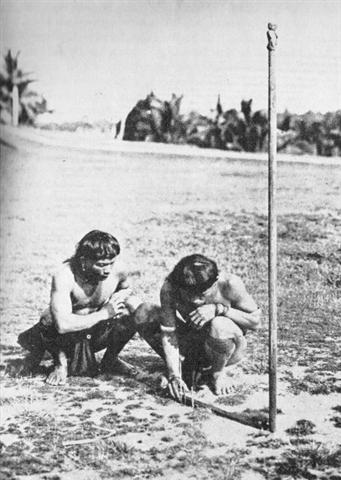
In southeast Asia the male
always went first, followed by his wife like a shadow. This
could explain what it meant when Atea changed to be a male - it was because
she began to go first.
The vertical upright
gnomon casts a shadow down on the horizontal Mother Earth. The 3rd husband of Atea was Faka-hotu
(make fruitful) and he (she) was a fruitful mother who gave
birth to Ru.
| Hotu
Ta.: hotu, to produce fruit, Sa.:
fotu, id. Mgv.: akahotu, the September
season. Churchill.
H.: Hoku, Night of the full
moon. When this moon set before daylight it was called
Hoku Palemo, Hoku that slips away. When it set
after daylight it was called Hoku Ili, grounded
Hoku. Ka mahina o Hoku, the full moon of the
night Hoku. Cf. hōkū, star. Hō
kū, star. (PPN fetu'u). Wehewehe. |
|
Ru
A chill, to shiver, to shudder, to quake;
manava ru, groan. Ruru, fever, chill, to
shiver, to shake, to tremble, to quiver, to vibrate,
commotion, to apprehend, moved, to agitate, to strike
the water, to print; manava ruru, alarm; rima
ruru, to shake hands. P Pau.: ruru, to shake,
to tremble. Mgv.: ru, to shiver with cold, to
shake with fever, to tremble. Mq.: ú, to tremble,
to quiver. Ta.: ruru, to tremble. Churchill.
Mgv.: eager, in haste, impatient. Ta.:
ru, impatience, haste. Churchill.
Ruru, to tremble, an
earthquake. Sa.: lūlū,
lue, to
shake. To.: luelue,
to roll; lulu,
to shake. Fu.: lulū,
to tremble, to shake, to agitate. Niuē: luelue,
to shake; lūlū,
to shake, to be shaken. Nuguria: ruhe,
motion of the hands in dancing; luhe henua,
an earthquake. Uvea, Ha.: lu,
lulu,
lululu, to shake, to
tremble, to flap. Fotuna: no-ruruia,
to shake. Ma.: ru,
ruru, to
shake, an earthquake. Ta., Rarotonga, Rapanui, Pau.:
ruru, to
shake, to tremble. Mgv.: ru,
to tremble; ruru,
to shake. Mq.: uu,
to shake the head in negation; uuuu,
to shake up. Uvea: ue i,
to shake; ueue,
to move. Rapanui: ueue,
to shake. Churchill 2. |
Before noon the Shadow (Ata) is
in the west because the Sun is in the east. After noon the
Shadow is in the east and the Sun in the west. If we should
regard the horizon in the east as earlier than the horizon in
the west - which is quite natural because everything descending
in the west has earlier risen in the east - then Atea
could have been lika such a shadow. At noon she was neither in
the east nor in the west, she was in an ambivalent place.
| Atea
The name of the district or section of
country over which Olopana is to have ruled in
Kahiki was in Hawaiian Moa-ula-nui-akea.
Analyzing this word, it consists of one appellative,
Moa, and three adjectives or epithets, ula,
nui, akea, 'red, great, open, or
wide-spreading' ... (Fornander)
Pau.: fakaatea, to remove, to
put away. Ta.: atea, clear. Mq.: atea, id.
Sa.: ateatea, wide, spacious. Ma.: atea,
clear. Churchill. |
| Ata
Ata 1. Dawn,
first light before sunrise; ku-hamu-á te ata ,
dawn has broken; ku-tehe-á te ata, it's already
dawn (lit.: the lights have flown). 2. Particle inserted
between the imperative prefix ka and the verb to
signify 'well, carefully, intelligently':
ka-ata-hakarivariva, prepare it well. Between the
prefix e and kahara it expresses 'to make
sure that, to take good care that...' : e-ata-kahara
koe o oona, be careful not to get dirty;
e-ata-kahara koe o kori te moa o te tahi pa, be sure
not to steal chickens of another property. 3. More:
iti, small; ata iti, smaller; he-ata-ata
iti-iti ró, the smallest of all. Vanaga.
Âta 1.
Shadow: he-veveri te poki, ana tikea toona âta,
the child is frightened at seeing his shadow; person's
reflection (in mirror, in water): he âta oou-á,
it's your own reflection. 2. To be frightened by a
shadow: he-âta te îka, the fish are frightened
(and they flee) by people's shadows. Vanaga.
1. Image, picture, portrait, design;
to draw, to paint (shadow sense). P Mgv: ata,
image, likeness, portrait, shadow of a human being,
form, shape, appearance, imprint, impression. Mq.:
ata, image, statue, portrait, shadow, surface; to
design, to mark. Ta.: ata, shade, shadow
appearance, form, representation of an object, cloud,
cloudy. 2. Transparency, end of day, sunset (bright
sense); e ata, red clouds; ku ata,
transparent; ata mea, ata tea, ata tehe,
dawn, daybreak, sunrise; ataata, end of day,
sunset. P Mgv.: ata, morning or evening twilight,
daybreak, dawn; ata haihai, evening twilight, a
beautiful sunset; ataiai, twilight, clouds red
with the sunset; atakurakura, a beautiful sunrise
or sunset; atareureu, dawn, the first peep of
day, morning twilight. Mq.: ata, to appear, to
rise, to shine (of stars); ata uá, morning
twilight; ataata, diaphanous, transparent. Ta.:
ata, twilight. 3. A designation of space; ata
hakahohonu, abyss; ata hakaneke mai, nearby,
close at hand; ata tapa, lateral, marginal. 4 ?
Ata kimikimi, to inquire; ata puo, to hill
a plant; ata ui, to examine, to taste. Churchill.
Atahenua (ata 3 -
henua 1), landscape, countryside. Atakai: 1.
Generous, hospitable, beneficent, indulgent, liberal,
obliging; prodigality, indulgence; rima atakai,
benevolent, generous, open-handed; gift, liberality. 2.
Calm, unperturbed, grateful. Churchill.
Ata-ta T, evening (? ataata).
Atatehe (ata 2 - tehe 1), dawn;
popohaga atatehe, morning, early in the morning.
Churchill. |
Noon corresponded to
midsummer and at midsummer the Sun was always at Sirius - Te
Pou. In Ga5-3 there is no real henua ('earth
shadow'). But in Ga4-27 there is
a descending male pole where normally, in this type of glyph, there
should have been a henua:
 |
 |
 |
 |
 |
|
Ga4-23 |
Ga4-24 |
Ga4-25
(108) |
Ga4-26 |
Ga4-27 |
|
JULY 5 |
6 (*107) |
7 |
8 |
9 (190) |
|
JULY 1 |
2 |
3 |
4 (185) |
5 |
|
φ Leonis (170.0), Alula (170.5),
Labrum (170.6) |
σ Leonis (171.1), λ Crateris
(171.6), ι Leonis, ε Crateris
(171.9) |
γ Crateris, π Centauri (172.0), κ
Crateris (172.5), τ Leonis (172.8)
GREDI |
ο¹ Centauri (173.8) |
GIAUZAR
(174.0), ξ Hydrae (174.3), ο²
Centauri, λ Centauri (174.8) |
|
September 7 (250) |
8 |
9 |
10 |
11 |
|
ºSeptember 3 |
4 |
5 (*168) |
6 (249) |
7 |
|
NAKSHATRA DATES: |
|
JANUARY
4 |
5 (*290) |
6 |
7 |
8 (373) |
|
DECEMBER 31 |
JANUARY 1 (*286) |
2 |
3 (368) |
4 |
|
AL NA'ĀIM |
ο
Gruis,
Snowball Nebula
(355.0), τ Oct. (355.3) |
no
star listed (356) |
ι
Phoenicis (357.3), ι Piscium
(357.4),
λ ANDROMEDAE
(357.9) |
|
ο Cephei
(353.3),
KERB
(353.6) |
κ
Piscium (354.2), θ Piscium (354.4),
υ PEGASI
(354.9) |
|
March 9 |
10 |
11 |
12 |
13 (72) |
|
ºMarch 5 |
6 (*350) |
7 |
8 |
9 (68) |
The position of Sirius was
a Sun event, not something dependent on the fixed stars.
Therefore the correct procedure could have been to consult the
Gregorian calendar. The date at Ga4-27 consequently was - when extrapolated
back in time - JULY 5 (not JULY 9).
In rongorongo times the
first day after heliacal Sirius was when Kerb (τ Pegasi) was
close to the Full Moon = September 7 (250). Thus there was a
jump from Sirius at June 30 (181) to day 250 (as based on the fixed
stars). 250 - 182 = 68 days had to be added in order to reach
the correct star time.

... The name
Salm (for τ
Pegasi, Kerb) is also the name of the eldest son of king
Fereydun, another name of which was Apam Napat
('Son of Waters'):
Salm
is a character in the Persian epic
Shahnameh.
He is the oldest son of [the] legendary hero and king
Fereydun. It is believed that his name was given to him by
his father, after Salm chooses to seek safety and run
instead of fighting the dragon that had attacked him and his
brothers (the dragon was Fereydun himself who had
disguised himself to test his sons) ... When Fereydun
decides to divide his kingdom among his sons, he gives Salm
[the timid unmanly one] Anatolia and West [the female side of
the kingdom] ... Fereydūn ... [is] also called Apam
Napat, 'Son of the Waters' ...
...
τ,
4.5, with
υ,
was Al Sufi's Sa'd al Na'amah, which Knobel thinks should
be Al Na'āim, the Cross-bars over a well; but they also
were known as Al Karab, the Bucket-rope. The usual titles
for τ
- Markab and Sagma or Salma - are from
Bayer, but the last two should be Salm, a Leathern Bucket
...
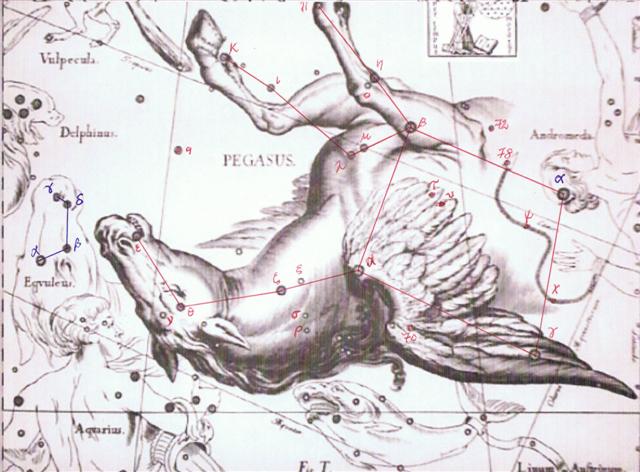
A fish was 'climbing' (kake) in Ga4-21 and there
was a dot in
front at Sirius, which - remarkably - in rongorongo times 'happened to be'
where also the pair δ and θ Leonis (Zosma respectively Coxa)
rose with the Sun:
 |
 |
 |
|
Ga4-20 |
Ga4-21
(104) |
Ga4-22 |
|
JULY 2 |
3 |
4 (185) |
|
JUNE 28 |
29 |
30 (181) |
|
11h
(167.4) |
Al
Sharas (168.6) |
Al
Zubrah-9 /
Purva
Phalguni-11 |
|
χ
Leonis, χ¹ Hydrae (167.1), χ² Hydrae (167.3) |
ZOSMA
(169.2),
COXA
(169.4) |
|
September 4 |
5 (248) |
6 |
|
NAKSHATRA DATES: |
|
JANUARY
1 |
2 |
3 (368) |
|
DECEMBER
28 |
29 |
30 (364) |
|
23h
(350.0) |
Simmah (351.7) |
φ
Aquarii (352.0),
ψ
Aquarii (352.4),
χ Aquarii
(352.6), γ Tucanae, φ Gruis (352.8) |
|
υ, θ Gruis (350.0), π
Cephei (350.6), ι Gruis (350.9) |
|
March 6 |
7 (66) |
8 (432) |
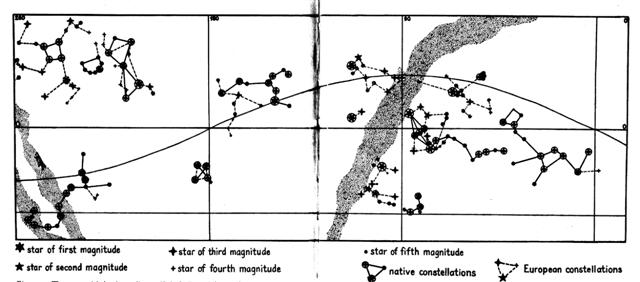
... There was
no water in the village. The lakes and rivers were dry.
Raven and Crow, two young girls who were having their first
menstrual courses, were told to go and draw water from the
ocean. Finding the journey too long, Raven decided just to
urinate into her basket-bucket. She decieved no one and was
severly scolded. Crow returned much later but with drinking
water. As a punishment, Raven was condemned never to find
water in the summer; only in winter would she find something
to drink. For that reason the Raven never drinks during the
hot months; she speaks with a raucous voice because of her
dry throat ...
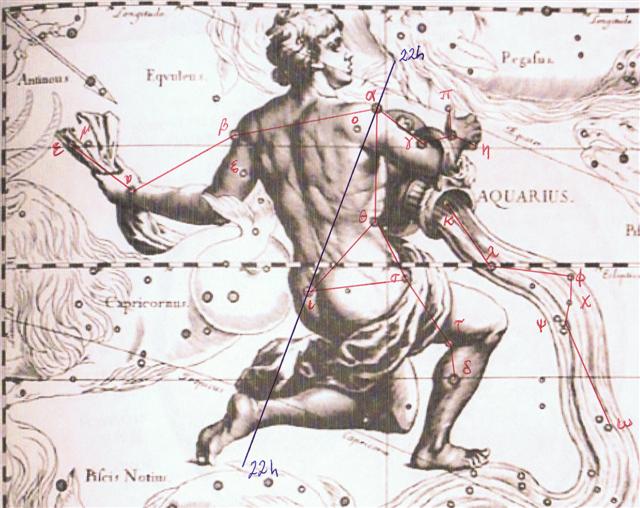
A pair of star kings, Regulus (α
Leonis) and Sadalmelik (α
Aquarii), ruled the year:
 |
 |
 |
 |
 |
 |
 |
|
Ga4-1 |
Ga4-2 |
Ga4-3 |
Ga4-4 |
Ga4-5 |
Ga4-6 |
Ga4-7
(90) |
|
JUNE 13 |
14 (*85) |
15 |
16 |
17 (168) |
18 |
19 |
|
υ¹
Hydrae (148.4),
RAS
ELASET
BOREALIS
(148.7) |
Tseen Ke
(149.9) |
ν Leonis
(150.1), π Leonis (150.6) |
υ²
Hydrae (151.8) |
Al
Jabhah-8 /
Maghā-10
/
Sharru-14 |
λ Hydrae
(153.2) |
Adhafera,
Tania Borealis, Simiram (154.7) |
|
10h
(152.2) |
|
AL
JABHAH
(152.4),
REGULUS
(152.7) |
|
August
16 |
17 (229) |
18 |
19 |
20 |
21 |
22 |
|
NAKSHATRA DATES: |
|
DECEMBER
13 |
14
(*268) |
15 |
16 (350) |
17 |
18 |
19 |
|
Kuh (331.4), γ Gruis
(331.5) |
no star listed (332) |
η Piscis Austrini
(333.4) |
22h
(334.8) |
ι Pegasi (335.0), Alnair
(335.1), μ Piscis Austrini, υ Piscis Austrini
(335.3), Woo (335.7), Baham, τ Piscis Austrini
(335.8) |
ζ Cephei (336.2), λ
Cephei (336.3), -/270 Lac. (336.7), λ Piscis
Austrini (336.8) |
μ Gruis (337.0), ε
Cephei (337.2), 1/325 Lac. (337.3), Ancha (337.4), ψ
Oct. (337.5), α Tucanae (337.9) |
|
Kae Uh (334.0), Al
Kurhah (334.4),
SADALMELIK,
Al Dhanab (334.6), ι Aquarii, ν Pegasi
(334.7) |
|
February
15 |
16 |
17 (14 *
29½) |
18 (414) |
19 |
20 |
21 (52) |
350 - 168 = 182 was the distance between
these kings and 368 - 185 = 183 could have been the distance
between their queens - one fetching water in the flow from the Urn of
Aquarius and the other staying behind.
|
10h |
REGULUS |
JUNE
17 (168) |
August 20 (232) |
|
22h |
SADALMELIK |
DECEMBER 15 (350) |
February 18 (414) |
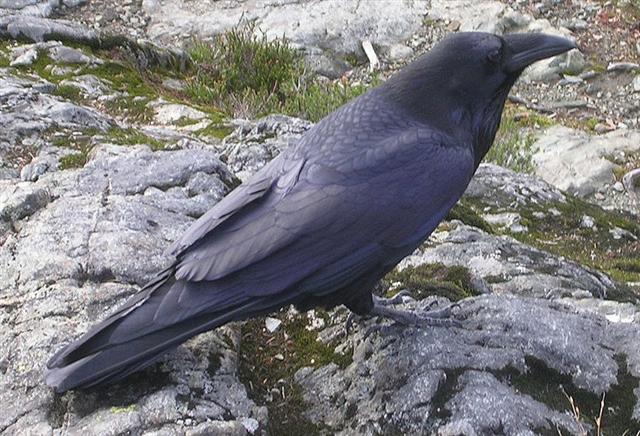
|
RAVEN |
ZOSMA, COXA |
JULY
4 (185) |
September 6 (249) |
|
CROW |
φ,
ψ, χ AQUARII |
JANUARY 3 (368) |
March 8 (432) |
Zosma and Coxa could have represented
the positions of Raven and Crow before they were sent to fetch water to
the thirsty village. Raven did not go and instead stayed
behind and urinatad (as Leo) into her bucket (the empty
Crater), while Crow may have gone straight across - like the crow
flies - to the opposite side of the
sky, to the spout from the Urn with fresh water.
|















